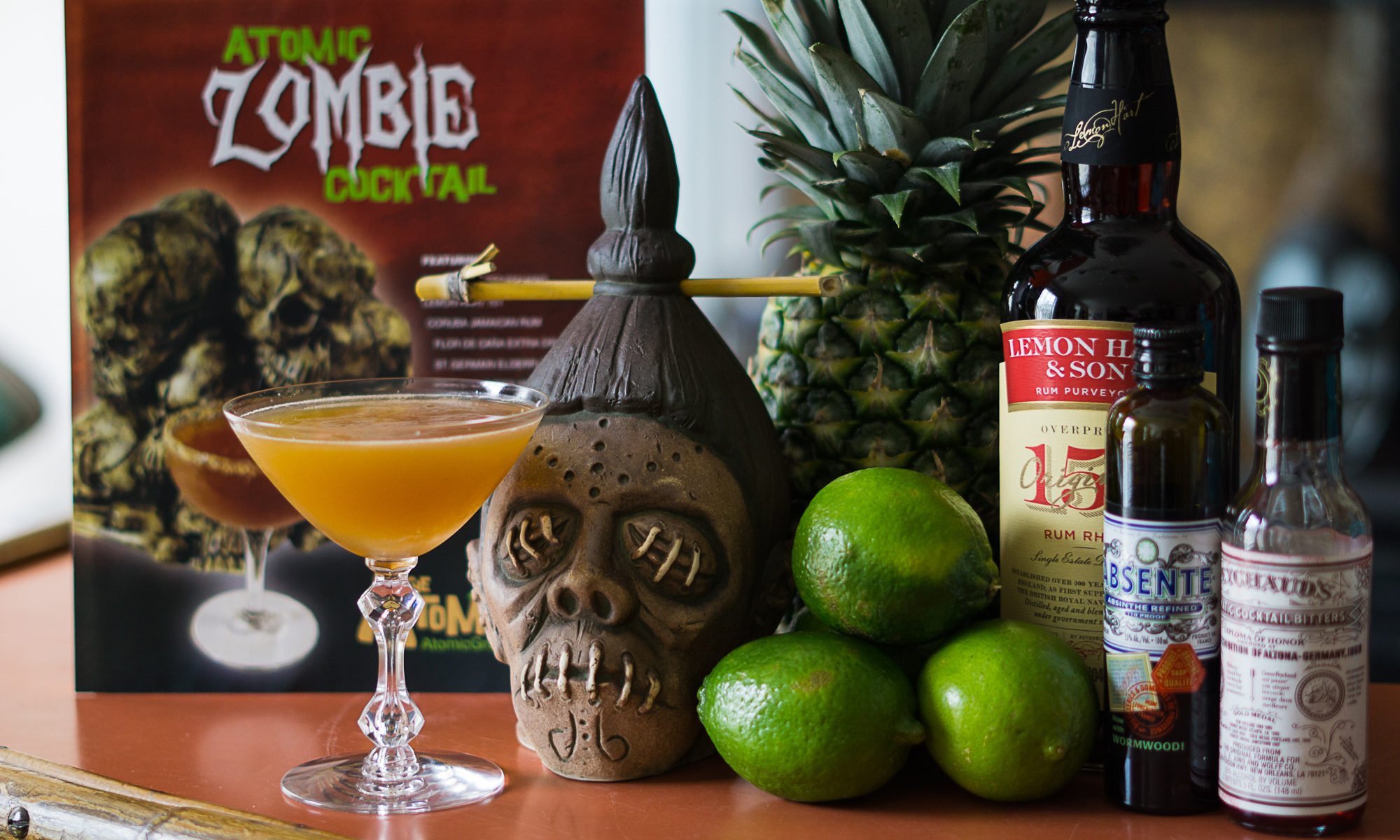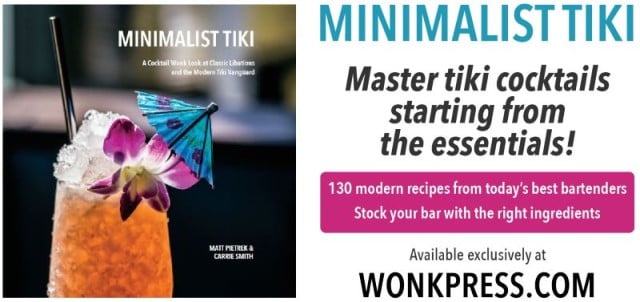Updated August 2023
See below: Cuban Daiquiri review | NEW: Official Mai-Kai recipe
Related: The Derby Daiquiri: The Mai-Kai’s ‘$100,000 drink’ is worth its weight in gold UPDATED
* The story of the Floridita Daiquiri rivals any novel
More Mai-Kai Daiquiris: Special Reserve Daiquiri | Banana Daiquiri | Strawberry Daiquiri
* Mai-Kai cocktail guide | More “lost cocktails”
* More Daiquiri recipes | Cocktail Recipes, A through Z
The humble Daiquiri is arguably the most definitive rum cocktail, perhaps even the prototype for the 20th century tropical drink explosion. It influenced Don the Beachcomber, Trader Vic, and countless others who followed in their footsteps.
Cuba’s most famous cocktail can be traced back to the late 1800s, but the simple combination of rum, lime and sugar was not groundbreaking. Martinique and Guadeloupe had the Ti Punch while Jamaica had its Planters Punch. An argument can be made that this intoxicating combination was invented on the high seas in the 1700s, when the British Navy introduced Grog to its sailors.

In this pantheon, the Daiquiri is distinctive for its precise craft and the clean, crisp rum of its homeland. In Potions of the Caribbean: 500 Years of Tropical Drinks and the People Behind Them (2014), Jeff “Beachbum” Berry praised the Daiquiri as the most perfectly balanced of all the rum-lime-sugar proto-cocktails.
Though deeply linked to Cuba, the Daiquiri was actually invented by an American engineer, Jennings Cox, who ran a mining company in the small village of Daiquiri during the Spanish-American War. The original was more like a punch, batched and served over crushed ice. It was not reconfigured into a single cocktail, strained into an empty coupe, until around 1913, after Cox’s death
That’s when the Daiquiri really began to take off. Its popularity grew from a local favorite to a destination drink for tourists who flocked to the Caribbean island’s legendary bars such as Havana’s La Floridita, especially during Prohibition. It also caught the attention of Facundo Bacardi, who used the simple drink to promote his expanding rum empire.

It’s likely that both Donn Beach (aka Don the Beachcomber) and Victor Bergeron (aka Trader Vic) ran across the Daiquiri during their travels in the Caribbean before opening their bars in California that kick-started the Tiki cocktail craze in the 1930s.
Their menus are loaded with Daiquiris, much like The Mai-Kai. Open since 1956, the South Florida historic landmark still features many drinks that can be traced back to Donn Beach, such as the Special Reserve Daiquiri.
There’s also a blended classic (Floridita Daiquiri) and an acclaimed original creation of mixologist Mariano Licudine, the Derby Daiquiri.
Of all the Daiquiris that appeared on a Mai-Kai menu, the Cuban Daiquiri is the only one that faded into the history books. It was an opening-day drink in 1956, but it likely became a victim of the era’s political upheaval, not to mention the U.S. economic embargo against Cuba that began in 1960 and lasts to this day.

Before the 1958 revolution, Mai-Kai owners Bob and Jack Thornton were known to take weekend jaunts to the island aboard a private plane. They brought back rare bottles of Cuban rum, which can still be found displayed in the restaurant’s back bar (see photo below).
The Derby Daiquiri took the Cuban Daiquiri’s place on the menu in 1959. It was revived during a menu expansion in the early 1970s, but it was removed for good in the 1980s and became largely forgotten.
The Daiquiri was sullied during the cocktail dark ages of the late 20th century by cheap imitations and dreaded frozen slushie-style machines. But the classic recipe maintained a quiet dignity. The traditional Daiquiri has seen an amazing resurgence during the 21st century craft and Tiki cocktail revival.
Bartenders around the world have rediscovered the classic, making it a litmus test of their mixology prowess. It continues to generate much discussion among rum and cocktail enthusiasts and inspire award-winning mixologists such as Julio Cabrera of Miami’s Cafe La Trova.
It’s the perfect time to take a look back and enjoy The Mai-Kai’s 1956 version of this timeless classic.
CUBAN DAIQUIRI
Okole Maluna Society review and rating
Size: Small
Potency: Mild
Flavor profile: Tart lime, light yet flavorful rum and a touch of sweetness.
Review: A classic Daiquiri using the finest ingredients.
Rating: 2 1/2 out of 5 stars (see how it ranks). On today’s menu, it would rank at the lower end of the rankings due mainly to its simplicity and lack of a “wow factor” (plus the unavailability of Cuban rum).
Ancestry: The Mai-Kai’s take on a traditional Daiquiri from the land where the drink was invented was also likely an exact copy of the same drink on Don the Beachcomber’s menu, including the signature green cherry. It was featured on the original 1956 Mai-Kai menu, but it was replaced by the Derby Daiquiri in 1959. The revolution just 90 miles south of Key West likely expedited its removal.
Bilge: Around the same time The Mai-Kai introduced the Derby Daiquiri, Don the Beachcomber menus saw the Cuban Daiquiri replaced with the Royal Daiquiri (featuring the same green cherry), undoubtedly using a different rum due to the embargo. The Mai-Kai turned to Puerto Rican rum when Cuban rum became unavailable.
Agree or disagree with this review? Share your comments below!
OFFICIAL MAI-KAI RECIPE

The following recipe was shared by manager Kern Mattei in August 2023 at The Mai-Kai’s Daiquiri seminar at Tiki Oasis. It’s very much a traditional Daiquiri, but the proportions are slightly different than the tribute recipe we previously posted (1 ounce lime juice, 3/4 ounce simple syrup, 2 ounces rum).
Cuban Daiquiri
- 1/2 ounce fresh lime juice
- 1/2 ounce simple syrup
- 1 1/2 ounces Cuban rum (or any lightly-aged and filtered Spanish-style rum)
Shake with ice and strain into a coupe glass with an ice shell and green cherry.
Ingredient and mixing notes

Like another lost cocktail in the Daiquiri family, Liquid Gold, this drink appeared on the 1956 menu with a distinctive ice shell. However, just like the Don the Beachcomber ancestor, it has a slightly smaller cove of ice. So when I first made this back in 2013, I simply modified the Cuban Daiquiri’s ice feature just a bit to match the 1956-57 menu (see photo). Refer to the Special Reserve Daiquiri recipe for step-by-step instructions on making the shell.
Before he was manager, Mattei worked in the bar in the 1980s and remembers the Cuban Daiquiri and its ice shell. It was one of the smaller ice features and didn’t extend above the rim of the glass, he said. The green cherry was inserted into the ice when the glass was prepped. If they ran out of glasses with ice shells, he said, they simply dropped the cherry into the drink. If you skip the ice feature, you could also adhere the cherry to the glass by freezing it for a few hours before serving. Nobody really knows the significance of the green cherry in the Cuban Daiquiri, but it’s also used alongside red cherries in the Special Planters Punch.
The Mai-Kai’s Cuban rum of choice in the 1950s was most likely Bacardi. We’ve seen it listed on an early rum purchase list, and bottles can be found in the restaurant’s rare rum collection. After the revolution, the government took over rum production and nationalized the Havana Club brand. It’s now one of the world’s most popular rums (co-owned since 1994 by Pernod Ricard). Except in the United States, of course. It’s unavailable here because of the embargo, and a trademark dispute has enabled Bacardi to release its own Havana Club rum (produced in Puerto Rico).

True Havana Club from Cuba is not hard to find, however, and we try to keep it stocked behind the bar at The Atomic Grog. The brand’s lightly aged and filtered (aka white) rums – Anejo 3 Años and Añejo Blanco – make an outstanding Daiquiri. Lacking Havana Club or another Cuban rum, we suggest some of those made in a similar style and tradition: Cana Brava (Panama), Flor de Cana (Nicaragua), and Brugal (Dominican Republic) are all solid choices. At Tiki Oasis, we used Don Q from Puerto Rico, a longtime staple at The Mai-Kai.
As detailed in our Derby Daiquiri review, The Mai-Kai uses Key lime juice instead of juice from the generic Persian limes that are ubiquitous in cocktail bars. It gives many of the drinks a more intensely tart flavor profile. Used in a small amount here, it also keeps the drink’s from becoming too watered down.
While some traditionalists will argue for granulated sugar in a Daiquiri, The Mai-Kai uses a basic 1:1 syrup like most bars for its ease of use. This also avoids any possible gritty texture from undiluted sugar. If you prefer the classic, feel free to use two teaspoons of fine sugar, but you may want to increase the lime to 3/4 ounce to keep the cocktail in balance – particularly if you’re using Persian limes.
Okole maluna!
PLEASE DRINK RESPONSIBLY!





Nice writeup. I can’t tell you how frustrating it is to go to a bar where they can’t even make a decent shaken Daiquiri. Went out last week to a place in Melbourne Beach that is considered to be better than average as far as their cocktails, and was met with a blank stare when I ordered a shaken daiquiri, strained, up. What I actually ended up being served was a short pour of rum served to me on ice with way too much simple syrup and. . . ROSE’S FRIGGIN’ LIME JUICE! The dude was 3 feet from a basket full of beautiful fresh limes and a benchtop juicer on the back bar that apparently was just for decoration. Biggest waste of 10 Cane rum I have ever been served.
My perfect rum/lime/simple ratio is the one Rumdood posted a few years back: 2 oz rum, 0.75 oz lime, and just 1 tsp. simple. Dialing back both the lime and the sugar while keeping them in balance with each other lets the rum notes stand out a bit more which I like. I’ll also go traditional Floridita at home as often as not at home with a bit of Maraschino liqueur, or Hemmingway on the very rare occasions where I can find fresh white grapefruit.
Thanks for the spot-on comments. I too have been in the same situation. I once went to a local “rum bar” that had a very impressive selection but no clue on how to make a daiquiri. They claimed they didn’t have fresh limes in the building, even though the bar also had a restaurant that served Caribbean dishes, so I’m sure they did. Not surprisingly, it closed not too long after. A great rum collection totally gone to waste.
I just had a great Hemmingway Daiquiri recently at the Rum Renaissance Festival at the Papa’s Pilar seminar. Check out this new rum inspired by Hemmingway … it should be available throughout Florida:
https://www.papaspilar.com
I’ll be posting a review of the rum and the seminar soon.
Plantation 3 star is the best rum to use when Cuban rum is called for (can’t buy the real Havana Club here). I use P3 in all my daiquiris. La Florida bar has the best seminal rum recipes of any I’ve made and tasted.